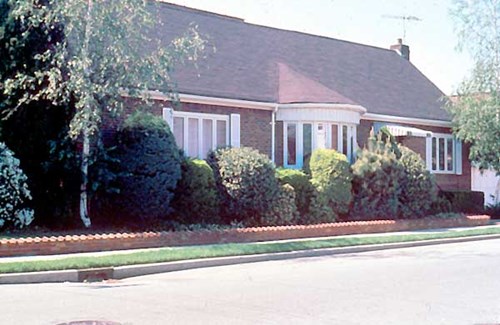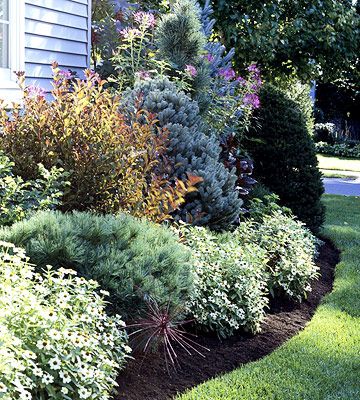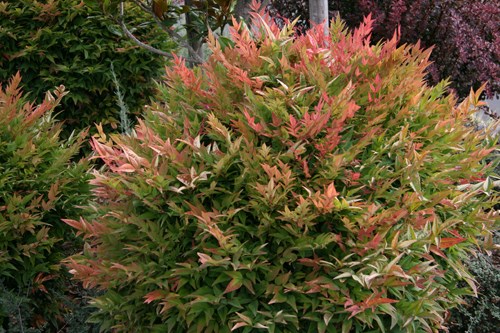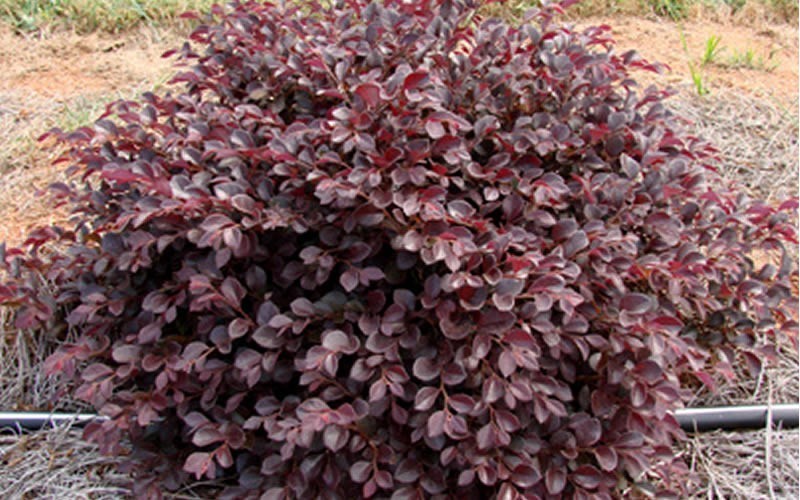Evergreen foundation plants have long been the backbone of the home landscape. Originally, these plantings were considered necessary to disguise the unattractive exposed foundations of houses and porch constructions that were common in the early part of the 20th century. Additionally, they aimed to tie the house to the ground visually, and to soften the architecture. Although few homes built today suffer from those same design flaws, the practice of lining the front of a home with a continuous row of evergreens remains.

Often, those plants are installed by contractors without any consideration whatsoever as to the mature size of the shrubs, resulting in a few years in an overgrown nightmare of pruning maintenance. The idea of softening hard lines and harmoniously blending the home into the landscape is entirely valid; however, many times this is completely overdone, resulting in looking like the house is peeking out over a green turtleneck. Most houses today are constructed with facing materials built to within 6 inches or less of the ground, so there is nothing to conceal. Strangely, I have even seen homes richly adorned with handsome stonework, pointlessly covered with a thick collar of evergreens.
Foundation plantings may best be approached as a combination of an entrance garden around the front door, and corner plantings, brought out deeper from the house, that serve as anchor points. If the house is wide and a contiguous bed is desired, the front and corner plantings can be connected by groundcover or low-growing perennials under windows, and deciduous flowering shrubs may adorn a larger wall expanse between windows. The best foundation plantings for other than extremely formal homes might include 50% evergreen shrubs, 25% perennials, and 25% annuals.
Plantings are best layered with
shorter elements toward the front. Beds should be at least 6-8 feet deep,
and the shrubs at maturity should grow no closer than 1 foot minimum from the
walls for maintenance purposes. Setting foundation plantings a bit farther
from the wall, and leaving adequate space between individual shrubs will
increase air flow which may lessen the chance of foliar disease.
Shrubs should be chosen carefully, paying strict attention to mature size and habit. The aesthetic value of many shrubs is ruined by the pruning required to keep the wrong size plant in the “right” place. The worst I have ever seen is a weeping Japanese maple pruned to a square, unsightly specimen in a narrow space next to an oft-traveled sidewalk. It likely looked lovely the day it was planted, but now reminds me of the man in the iron mask, sentenced forever to a sad and painful existence. Fortunately, plant breeders today are apparently aware of the fact that most of us have smaller spaces and have met that challenge with an ever-increasing selection of dwarf shrubs. Combine that with the fact that our climate is a bit warmer than it was decades past, and it opens new possibilities for foundation plantings in the Mid-Atlantic. When shopping, look for branded shrubs from Proven Winners, First Editions, Garden Debut, and Southern Living. These represent the latest developments in the horticultural industry, and you will likely find attributes in these plants that were not previously available. Do be prepared to pay a bit more—plants today are often patented, and as a result those new introductions carry a somewhat heftier price tag. And remember that new doesn't necessarily mean better. The original species or older cultivars of a plant may be desirable, if not cheaper, alternatives. Make sure that “new” means an actual improvement that works for you, such as smaller mature size, improved disease resistance, or longer flowering. An improvement should reduce maintenance or increase aesthetic value enough to make it worth the extra money.
New plants to check out!

Nandina, commonly called heavenly bamboo, is understandably popular. Not a true bamboo at all, the species boasts mostly evergreen foliage, white summer flowers, and an outstanding display of red berries in winter. Mature plants may reach 6 to 8 feet high and wide and are highly adaptable to varied soils and exposure. Pruning is usually not necessary, but if size must be controlled it is best to prune selected stems to the ground, or head back stems to varying heights to control legginess. In a very bad winter, Nandina may emerge looking a sad and bedraggled mess in spring. Not to worry! They will bounce back quickly, and often fill in fuller than they were before. In many states these are now listed as invasive. It is somewhat unfortunate that the entire species has been categorized as such, as many of the cultivars hardly (if ever, like ‘Firepower’) bloom, so the seed cannot be spread. In states that allow their planting, you may want to look for non-flowering varieties. Alternatively, cut the fruits off for holiday displays. Below varieties hardy zones 6-9:
- Gulf Stream: 3 to 3 ½ feet; upright; red winter foliage; may flower with age
- Obsession (Southern Living): similar to Gulf Stream, but improved red foliage fall through spring
- Firepower: about 2 feet; intense red winter foliage; no flowers or fruit
- Blush Pink (Southern Living): similar to Firepower, but improved red foliage fall through spring, some red to pink color in summer, depending on climate
- Harbor Belle: 1 to 2 feet; mounding, spreading with age; burgundy foliage fall and winter; flowers, fruits in colder climates
- Flirt (Southern Living): similar to Harbor Belle with improved red foliage fall through spring and red/green in summer
- Lemon-Lime: about 2 feet, bright chartreuse; flowering is rare
Cherry laurels are popular broadleaf evergreens, especially the 4-6 foot high and wide growing Otto Luyken, which is extensively used in foundation plantings. Unfortunately, they can suffer terribly from shot hole disease in wet weather or from too much overhead irrigation. Once infected, the leaves develop many holes, and eventually drop from the plant. There is currently no cure, although the fungicide Mancozeb may be effective to some degree. Experts have found bacteria as well as fungi in infected leaves, but there is no chemical to control the bacteria. These plants also require excellent drainage, succumbing to root rot in less-than-ideal conditions. This has caused some breeders to turn to substitutions for this popular evergreen. One plant that seems to show promise is Distylium. Although commonly called evergreen witchhazel, their winter flowers are relatively inconspicuous except upon close inspection, unlike the blooms of their more familiar deciduous cousins. The foliage, however, is an attractive blue-green to lustrous deep green, with smooth oval leaves lining each branch. So far, they suffer from no appreciable pest or disease problems, and are tolerant of varying soil conditions, heat, drought, and a fair degree of shade. According to Dr. Mike Dirr, professor of horticulture at the University of Georgia (and my horticultural idol), they are “the best new plant you've never heard of.” Developed over the last 15 years by Dirr and his partners, they are making their way in ever larger numbers into garden centers:
- Vintage Jade (First Editions): 2' high x 5' wide; layered, mounding habit; Z 6b-9
- Coppertone (First Editions): 5' high and wide; spreading, mounded habit; coppery new foliage in spring maturing to blue-green; Z 7-9
- Linebacker (First Editions): 8-10' high x 6-8' wide; glossy reddish-orange new foliage matures to deep green; also suitable for hedges and screens; Z 7-9
Purple-leaved shrubs always seem popular, as evidenced by the huge numbers of crimson pygmy barberries seen in home and commercial landscapes. It's such a shame that there isn't a plant that color that is also evergreen, right? Well, hold on to your sun hat—there is! You may not have heard of Loropetalum var. rubrum (botanical term var. rubrum simply means red-foliaged variety), but it's yet another great member of the witchhazel family. Besides being evergreen, another plus for loropetalum is that barberry is considered invasive in Maryland due to how easily it seeds, a problem not commonly experienced with loropetalum. Loropetalum have long been grown in the south but started entering our Mid-Atlantic landscapes in the last 10 years or so. The original varieties introduced grew quite tall and VERY fast. Their 8-12 foot size made them difficult to fit into smaller landscapes without a lot of pruning, which they do tolerate well, however. More recently, breeders have released dwarf varieties, typical mature sizes from 3-5 feet. Their foliage is evergreen to semi-evergreen, depending on the winter weather. Spring brings on an explosion of strappy hot pink flowers, which gives them their common name, Chinese fringeflower. Flowers may rebloom sporadically in summer and fall. Best sited in acid, moist, well-drained soil, they are quite tough once established, withstanding heat and drought. They tolerate sun or medium shade, and are deer, disease, and pest resistant. To quote Dirr, “Without equivocation, var. rubrum is among the most beautiful, reliable, and cherished recently introduced garden plants.” Varieties you may find today include Crimson Fire, developed by Dirr himself:
- Crimson Fire (First Editions): 5' x 7' cited by Dirr—note that typical garden catalogs list this as small as 2 to 2.5 feet; neon pink flowers in spring; ruby-red foliage year-round.
- Daruma: 2-5' high X 3-5' wide; bright pink flowers; deep plum foliage
- Jazz Hands Pink (Proven Winners): 1-3' high x 3' wide; pink flowers; purple-cranberry foliage; slightly less hardy—zone 7b, Purple Pixie (Southern Living): 1-2' high x 4-5' wide; cascading habit creates a carpeting effect; pink flowers; intense purple foliage; try cascading over a stone wall or covering a slope



